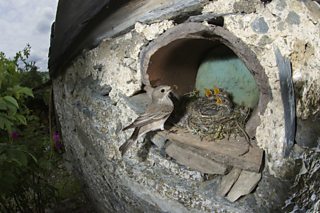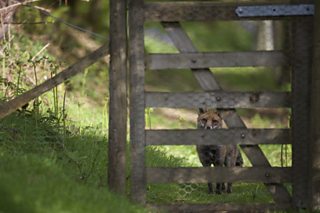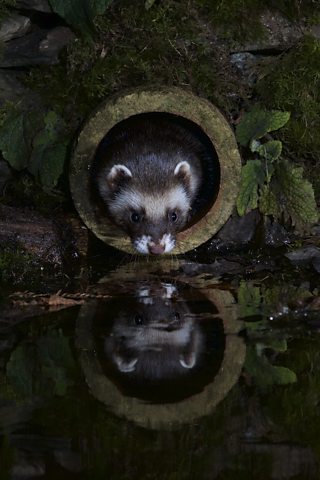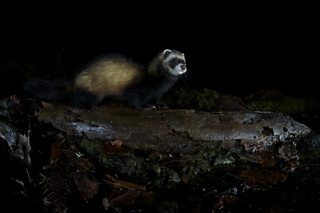Four years ago, Richard Bowler moved to rural Wales in the hope of photographing wildlife. He wasn't expecting what turned up in his garden...
I have always been interested in the natural world. Growing up we were lucky enough to have a house that backed onto part of the Chilterns, Blows downs in Dunstable, Bedfordshire. Weekends and school holidays would see me looking for slow worms, shrews and voles. Each spring I’d find various bird nests that I’d watch as the eggs hatched and the young developed. This was the 70’s, there seemed to be a lot more life about then. The hills of the downs buzzed with insect life and wildflowers. Perhaps it’s like saying the summers were always warmer and sunnier as a child, but I fear that is not the case.
In my teens my love of nature led me to fishing, to see and hold animals that were hidden from view under water was magical. This was to spark an interest in photography, at first to capture a record shot of what I had caught. But as I entered my 20’s I combined angling with travel. Soon destinations that I had only seen on David Attenborough programs were in reach, Africa, south and Central America were all visited.

Spotted flycatcher. Credit: Richard Bowler
These days I rarely fish, instead preferring to capture the wildlife of our countryside with a camera. My favourite subjects being Red foxes and Brown hares, I’m never happier than laying in a hedgerow watching and photographing either of these subjects. When we lived in Bedfordshire it was relatively easy to see either species out in the countryside at first light (my favourite time of day).
About 4 years ago myself and my partner Helen decided we wanted to leave the rat race. We found ourselves living on a small holding on the edge of the Berwyn’s in north Wales. Surrounded by vast open spaces and breath taking views I couldn’t wait to get started on photographing the local wildlife. That’s where the problems started; there wasn’t any or certainly not how I’d been used to seeing them. My beloved foxes are so persecuted that they are virtually nocturnal. Not wanting to give up on foxes I used trail cams to watch their behavior, however watching their reaction to a road kill pheasant in front of the trail cam soon showed me how on edge they are. Night after night the trail cam footage would show a fox looking at the pheasant but not daring to take it. I’m sure they could see the infrared light of the trail cam because the night the trail cam was removed the pheasant was taken.

Fox. Credit: Richard Bowler
The trail cam was not a complete failure though; it showed that we had a good population of Hedgehogs on the property. This led me to provide food for them at a reflection pool I had built to photograph birds from. Each evening I’d photograph the Hedgehogs as they came to feed by the pool and as I left I’d leave a trail cam going to see what else would visit. I was hoping for a fox, but to my surprise we got the odd visit from a Polecat. As the weather cooled the Hedgehogs started to hibernate but to my surprise the Polecat started to visit every night. To begin with the visits were very early in the morning around 1am, I needed to find a way to photograph him.
I had been using a trigger to fire my camera when using high-speed flash to photograph Swallows leaving the stables where they nest. A trigger works by firing your camera when either an infra red beam is broken or my personal favourite a PIR sensor, similar to a security light, senses movement and fires your camera. It was then a case of hiding some tidbits for the Polecat and pre focusing your camera where you hope the Polecat to be, simple. Well maybe not quite so, flashes are needed to light the subject at night, too much or too little light can spoil a shot. A good starting point is to have a couple of flashes on 1/16th power. Wide-angle lenses give a greater depth of field so I usually use lenses between 15mm and 35mm to make sure the subject is in focus. It’s also handy to have a trail cam going as your camera trap is fired, you don’t want to spook your subject so you can see how it reacts, also seeing how the animal approaches can help in finding the ideal spot to pre focus on.

Polecat. Credit: Richard Bowler
After some trial and error I was beginning to get some shots I was happy with, it also became apparent that Polecats are not photographed on a regular basis so a few opportunities opened up. I was commissioned by Johnny Birks to supply the images for his book on Polecats, Winterwatch got in touch with me with a view to filming the Polecats for the latest series and I got images of Polecats in the Times and a double page spread in the January edition of the 主播大秀 Wildlife magazine.
Over the last 2 winters my little reflection pool has been visited by 4 different Polecats. You can tell by the individual markings on their facial masks. All appear to be male and if this year is like last they will disappear to look for a mate in March, only making the occasional visit during the summer. All is not lost though, the techniques learned of using wide-angle lenses and my DSLR camera as a camera trap has opened up new possibilities to photograph animals in a different way. From Spotted flycatchers nesting in the stable walls to the Badgers and Foxes that visit my mum’s urban garden in Bedfordshire. My head is filled with new ideas and subjects.

Polecat. Credit: Richard Bowler

Credit: Richard Bowler
And what of my passion for foxes that led me to discover the nocturnal visiting Polecats. Last spring I had a brief encounter with a vixen, looking through the woodland gate, longingly at our chickens. I managed a quick image and over the course of last summer built up a relationship with her. Most evenings she would tolerate me laying down in the wild flower meadow photographing her as she ate tidbits I placed out for her. It was wonderful, our free-range chickens were never targeted, it was as if we had struck an agreement. All that came crashing down one day in late September, we came home to find thirty hounds and terrier men leaning on our gate. I’ll never know for sure what happened to her but we never saw her again. As for the future, I think our local foxes have enough to contend with so my fox photography will be continued in the 主播大秀 Counties. Leaving me to concentrate on the nocturnal masked bandit that calls our small holding home; the Polecat.
See Richard's set up and hear his story in the film from Winterwatch 2015.
